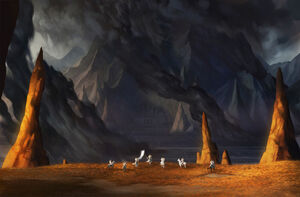
Thangorodrim
Thangorodrim was a group of three volcanic mountains within the Iron Mountains in the north of Middle-earth during the First Age. They were raised by Morgoth, who delved his fortress of Angband beneath them and far back into the iron mountains. They were the highest peaks in all of Middle Earth.
History
Thangorodrim was said to have been formed over the ages by the piles of slag from Morgoth's furnaces and rubble from the delving of Angband for ore to feed the great smithies of Morgoth's armies, but at the same time they were solid enough to form mountain high precipices. After the death of his father, Maedhros was taken prisoner and nailed to a cliff of Thangorodrim.[1], and Húrin was imprisoned on a high terrace.[2][3][4] The tops of Thangorodrim perpetually smoked, and sometimes spewed forth lava when Morgoth was on the warpath.
For a time the Great Eagles lived in eyries on Thangorodrim[5], but at some time during the First Age they moved to the Crissaegrim near Gondolin.[6]
At the base of the south face of the middle peak was the Great Gate of Angband, a deep canyon leading into the mountain, lined with towers and forts. There were also a number of secret gates scattered around the sides of the mountain group, from which Morgoth's hosts could issue forth and surprise their foes.
Thangorodrim was destroyed during the War of Wrath at the end of the First Age when Ancalagon, freshly slain by Eärendil fell dead on the peaks crushing them to rubble.[7]
Size and Height
The exact size and height of Thangorodrim are unclear. One drawing by Tolkien illustrated in Karen Wynn Fonstad's The Atlas of Middle-earth, if drawn to scale, would have made it 35,000 ft high, and the statement that it lay 150 leagues (450 Númenórean miles) north of Menegroth puts it too far away for some of the action in The Silmarillion to make sense; a distance of 150-200 miles would have been more consistent. It is possible that with the higher figure Tolkien was not referring to 'as the eagle flies', but rather 'as the wolf runs': the plateau of Dorthonion forced a long detour, which added the extra 200, 250 miles to the distance.[8]
Etymology
Thangorodrim was a Sindarin word that tied together the roots 'oppression', 'mountain', and 'group'; together meaning roughly 'Oppressive peaks'.[9]
Portrayal in Adaptations
Translations around the World
| Foreign Language | Translated name |
|---|---|
| Chinese (Hong Kong) | 安戈洛墜姆 |
| Russian | Тангородрим |
References
- ↑ The Silmarillion, Quenta Silmarillion, Chapter XIII: "Of the Return of the Noldor"
- ↑ The Silmarillion, Quenta Silmarillion, Chapter XX: "Of the Fifth Battle: Nirnaeth Arnoediad"
- ↑ The Children of Húrin, Narn i Chîn Húrin, The Tale of the Children of Húrin, II: "The Battle of Unnumbered Tears"
- ↑ The Children of Húrin, Narn i Chîn Húrin, The Tale of the Children of Húrin, III: "The Words of Húrin and Morgoth"
- ↑ The Silmarillion, Quenta Silmarillion, Chapter I: "Of the Beginning of Days"
- ↑ Unfinished Tales, Part One: The First Age, I: "Of Tuor and his Coming to Gondolin"
- ↑ The Silmarillion, Quenta Silmarillion, Chapter XXIV: "Of the Voyage of Eärendil and the War of Wrath"
- ↑ The Atlas of Middle-earth, The First Age, The Elder Days, "Thangorodrim"
- ↑ The Complete Guide to Middle-earth
